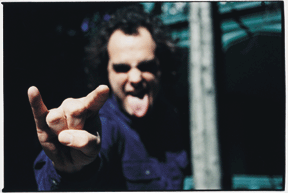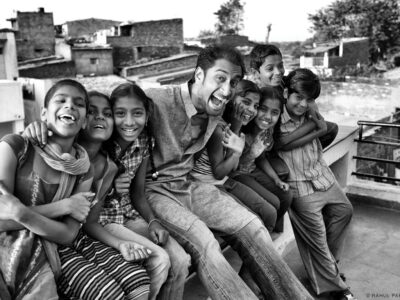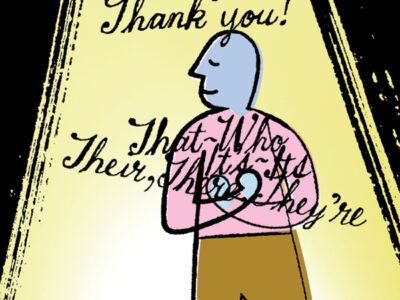
For Paul Green C’01 rock ‘n’ roll isn’t kid stuff. But don’t tell that to the more than 100 students, ranging in age from seven to 18, who attend the burgeoning Philadelphia-based school of rock music that bears his name.
A hard-working, to-the-point, and headstrong guy, Green wears a basic T-shirt, jeans, sneakers; his hair is permanently windblown. (Think: man listening to the stereo in the Maxell tape ads). Green’s conversational manner is utterly straightforward. He says, “I’m real tough with the kids”; he says, “You want to learn how to play rock music? Learn the first three Black Sabbath albums and the first five Led Zeppelin albums, and there you go. That’s where everything comes from.”
As a guitar teacher putting himself through college, Green started having his students jam together on weekends. Noticing how quickly they improved and excited by how good they were getting, he agreed to play an art opening in Old City in the late 1990s. News of the amorphous group soon spread like good gossip throughout the local art scene. Before long the band was playing shows at the art/design studio Space 1026, among other Philly in-the-know places.
As Green tells it, “Out of the blue a friend asked us to play at an art opening on First Friday and that’s when it really began; we had a lot of word-of-mouth and before I knew it we had a Philadelphia Magazine article about the band.”
Nearly 60 shows and a dozen articles later, including a Philadelphia Weekly cover story “Kid Rock,” and a loaded-with-attitude feature and photo spread in Spin, “Schoolhouse Rock,” written by Smashing Pumpkins guitar player James Iha no less, the school has grown from 18 students to its present enrollment of around 110. It has a staff of 14. Rather than pay lesson-by-lesson, the students pay a flat $100 monthly fee, which was another of Green’s ideas.
If art and education thinker John Dewey grew up listening to the The Rolling Stones, Pink Floyd and Frank Zappa, he might have founded the Paul Green School of Rock Music. The school operates from the premise that the best way to learn anything is by doing it. In the case of classic rock, that means “wood-shedding”—i.e., practicing—down at the school and “playing out” dozens of shows a year in front of thousands of fans. Ticking off the accomplishments like a proud parent, Green says, “At these concerts the kids have professional sound, light shows, and, when appropriate, smoke machines.”
Green studied philosophy at Penn, but he sees ideas mostly as wonderful tools for solving problems. “Having studied philosophy makes me look at things with a more critical eye.”
He is less concerned with passing along accepted knowledge than he is with stirring the kids up. In addition to music and band lessons, Green also holds forth in a new class at the school he calls, “Philosophy for Ungrateful Teenagers.” Green is trying to create continuity beyond the music by recommending books to read and movies to watch, to discuss how everything relates to everything else. About teaching music he says, “If you just practice and focus your energies, you can create a set of skills, and with those skills, find your independent voice.”
Likewise, Green doesn’t get tangled in the differences between teaching classic rock and classical music. “We start to treat the early classic rock music as the body of work you learn from to focus your abilities. Rather than drawing upon the classical music repertoire where all the keyboard players can play the Turkish March, all of our kids can play Paranoid, by Black Sabbath,” he says.
“We move towards shows that showcase their musical abilities—songs like Heart of the Sunrise, [by Yes] and their ability to improvise—that’s where we’re always going. Getting the songs down is just a start.” Green’s eyes slightly widen as he says, “It’s those moments where you put yourself into it—that’s what we really try to do. If I come back in five years and find these kids playing in cover bands—I’ll kill them.”
Halfway through our conversation I ask Green if the school might ever start to offer upper-level classes on how to give a rock interview? With no hesitation, he says, “My kids have done rock interviews. So that’s how they learn to do it. Spinmagazine comes out and interviews 20 or 30 kids, and seven of them get their names in the story—the other kids see what got them in and learn from that. When we took pictures, I said to one of our drummer kids, ‘Take your shirt off and write STUD on your chest with lipstick.’ He said, ‘OK I have to call my mom.’ He called his mom, she says OK, and he ends up in Spin magazine. But the best way to get noticed,” he pauses, then adds, “is to perform well.”
What’s in the future? The school now boasts a scholarship fund; Green has hired an agent and hopes to be playing New York, Boston, Baltimore, and D.C. in the near future; and Paul and his wife Lisa are expecting their first child. Lisa teaches vocals at the school, and with warmth in his voice, Green says, “She is the opposite of me personality-wise, and with the kids, that’s important.”
How big does he want to make the school? Green says, “When we hit 120 we’re closing enrollment. After that I’m focusing on getting new kids good, the good kids better, and the best kids out in front of whoever is there. That’s my goal: to make these kids as good as possible. My pipe dream would be that in five or 10 years from now there will be a Rolling Stone article like there was about Seattle, tracing back where all these new bands came from.”
—Tom Devaney




